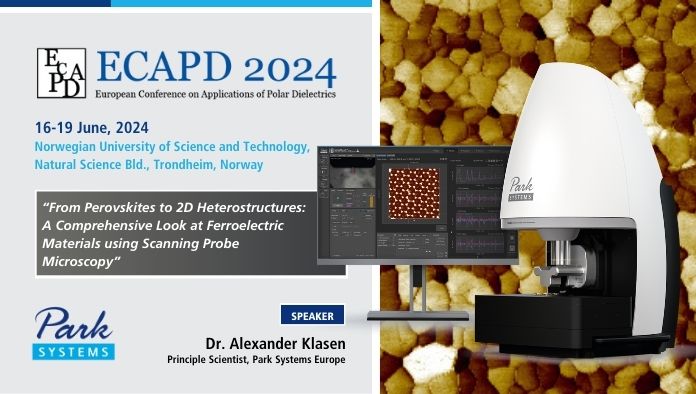
The ECAPD 2024, the European Conference on Applications of Polar Dielectrics, serves as a cornerstone event in the field, providing a dynamic platform for the exchange of groundbreaking ideas and discoveries. The main goal of this prestigious international conference is to facilitate discussions on recent advancements in theory, simulation, synthesis, and characterization, foster new scientific connections and collaborative ventures, and identify future pathways in the applications of polar dielectrics.
- • Date: 16-19 June 2024
- • Venue: Natural Science Bld., Norwegian University of Science and Technology (NTNU) , Trondheim, Norway
- • Our location: tbc
Make sure to visit our booth for an exclusive Park FX40 live demonstration, where you can witness cutting-edge technology in action. Engage with our experts, explore our latest offerings, and discover how our solutions can revolutionize your work in the field of polar dielectrics.
ECAPD 2024 will feature a diverse range of symposia organized into four topical areas, ensuring comprehensive coverage of the latest developments:
- • Applications of ferroelectrics, piezoelectrics, and related materials
- • Fundamentals of ferroelectrics and related materials
- • Materials design and processing
- • Characterization of polar materials
Each symposium will offer a deep dive into its respective area, providing attendees with insights into the latest research, emerging trends, and innovative applications.
_______________________________________________________________________________________________________________________

Join Dr. Alexander Klasen, Principle Scientist, Park System Europe, at the ECAPD 2024 for his talk
- ⏩ TITLE: “From Perovskites to 2D Heterostructures: A Comprehensive Look at Ferroelectric Materials using Scanning Probe Microscopy”
- ⏩ DATE: tbc
ABSTRACT
Dr. Alexander Klasen¹, Co-Author: Dr. Andrea Cerreta¹
¹ Park Systems Europe GmbH, 68199 Mannheim, Germany
Ferroelectric materials are widely used in modern electronic devices, from capacitors to data storage, sensors, transducers, and sound emitters.
These materials exhibit a spontaneous and switchable electric polarization that arises from a non-centrosymmetric arrangement of positively and negatively charged atoms within the crystal structure, which leads to a permanent electric dipole. A wide range of different components can be applied, ranging from classic components like metal oxides in a perovskite structure such as barium titanate or lead zirconate titanate to soft polymers like PVDF. In this talk, we provide an overview and introduction to three different modes of piezo force microscopy: off-resonance single-frequency PFM, resonance-enhanced single-frequency PFM, and dual-frequency resonance tracking (DFRT) PFM. We briefly discuss the advantages and disadvantages of these modes and demonstrate how they can be combined with a force-distance-curve-based mode to avoid lateral shear force and enable destruction-free imaging of various material properties such as adhesion and stiffness, as well as piezoelectricity on a local scale. Finally, we provide an outlook on how such investigations can be combined with other modes of the broad family of atomic force microscopy, like Kelvin probe force microscopy, by characterizing and switching ferroelectric domains in hBN/graphene 2D heterostructures. Accordingly, we present the versatility of AFM-based techniques to provide a comprehensive analytical toolbox for a large variety of samples.
_______________________________________________________________________________________________________________________





